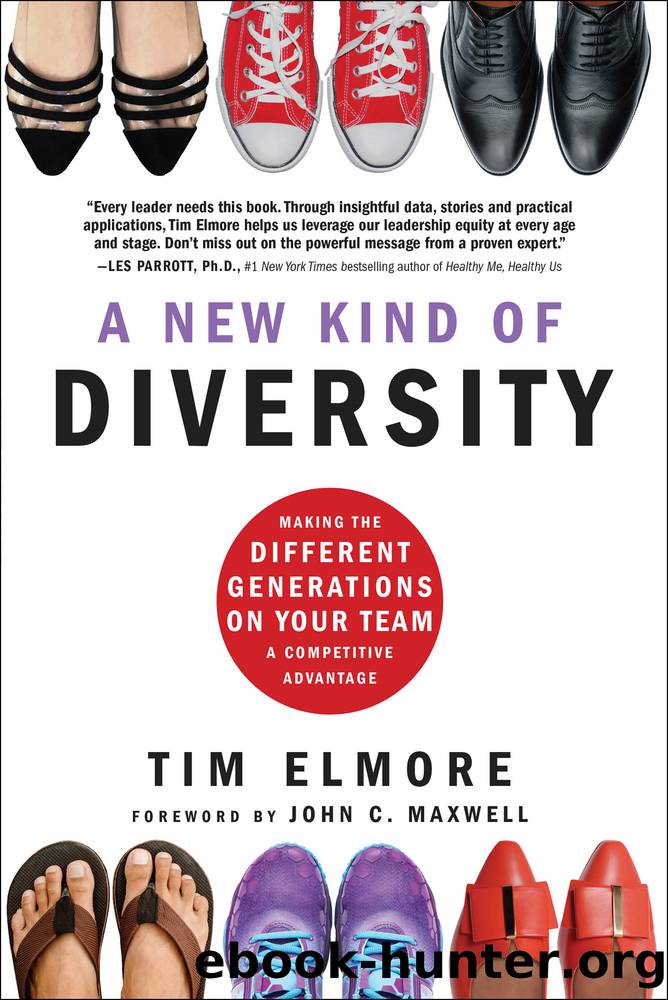A New Kind of Diversity: Making the Different Generations on Your Team a Competitive Advantage by Tim Elmore

Author:Tim Elmore
Language: eng
Format: epub
Publisher: Maxwell Leadership
Published: 2022-10-25T00:00:00+00:00
Let me say it againâin the Land of Tomorrow, Gen Z are the natives, and we are the immigrants. The emerging generation is usually seen as strange at first, and eventually everyone sees they bring those oddities into the future and often become the norm. These descriptions above are actually characteristics of the future for everyone. Our culture is migrating toward these realities, like it or not. This is all the more reason we must lead well.
THE RULES MAY BE CHANGING
While Generation Z are niched in a thousand different subgroups, Austin may be a vivid case study for us on this new generation. He was born in 2001 and identifies with Billie Eilish, the top Grammy Awardâwinner in 2020, whose songs are often about things that are dark and depressing. Austin is a nice guy who has different groups of friends on TikTok, Snapchat, and Instagram. If he were honest with youâlike he was with meâhe would admit to having major questions about his gender identity. Like many Gen Zers, he doesnât identify as binary. Heâs pretty sure heâs not heterosexual.
As a college student, he was overwhelmed by school, life, and an uncertain future. He takes meds for an anxiety disorder and would say anxiety has been normalized among his friends. Having older siblings, Austin feels heâs growing up in the shadow of the Millennial generation who are a step ahead in age and experience. He knows heâll be competing with them for jobs when he graduates, just as Generation X grew up in the shadow of the Boomers and felt they competed with them. He was diagnosed with ADHD in elementary school, and the meds for that have helped him become more focused. All the same, he still feels penalized by the whole pandemic.
More than anything, he is sure that no adult is going to swoop in and âsave the dayâ for him once he begins his career. Austin said to me, âWhy should I think that? Nobody knew what they were doing when the pandemic hit us all in 2020. I am going to hack my way through my career and figure it out myself.â He is part of a different generation than any in Americaâs past:
Theyâre the most diverse population at work: 48 percent are not white.
They own a smartphone (96 percent) and multitask on five screens a day.
Theyâre smart consumers: 35 percent plan to save for retirement in their twenties.
Salary is a top motivator (70 percent) and health insurance is a must (70 percent).
Almost 60 percent say they would work weekends for higher pay.
Unlike Millennials, only 38 percent consider work/life balance important.
Over 90 percent prefer to have human interaction at work instead of just screens.
Forty percent want daily interaction with their boss, and they feel somethingâs wrong without it.
Sixty percent want multiple check-ins with a team supervisor daily.40
Download
This site does not store any files on its server. We only index and link to content provided by other sites. Please contact the content providers to delete copyright contents if any and email us, we'll remove relevant links or contents immediately.
| Ethics | Etiquette |
| Fashion & Image | Health & Stress |
| Motivation & Self-Improvement | Work Life Balance |
| Workplace Culture |
Tools of Titans by Timothy Ferriss(8222)
Change Your Questions, Change Your Life by Marilee Adams(7637)
Deep Work by Cal Newport(6885)
Playing to Win_ How Strategy Really Works by A.G. Lafley & Roger L. Martin(5931)
Man-made Catastrophes and Risk Information Concealment by Dmitry Chernov & Didier Sornette(5924)
Digital Minimalism by Cal Newport;(5667)
Big Magic: Creative Living Beyond Fear by Elizabeth Gilbert(5615)
The Slight Edge by Jeff Olson(5352)
Ego Is the Enemy by Ryan Holiday(5295)
The Motivation Myth by Jeff Haden(5157)
Stone's Rules by Roger Stone(5027)
The Laws of Human Nature by Robert Greene(5001)
Tuesdays with Morrie by Mitch Albom(4695)
Eat That Frog! by Brian Tracy(4436)
Rising Strong by Brene Brown(4380)
Skin in the Game by Nassim Nicholas Taleb(4165)
Bullshit Jobs by David Graeber(4100)
The Money Culture by Michael Lewis(4082)
Skin in the Game: Hidden Asymmetries in Daily Life by Nassim Nicholas Taleb(3935)
